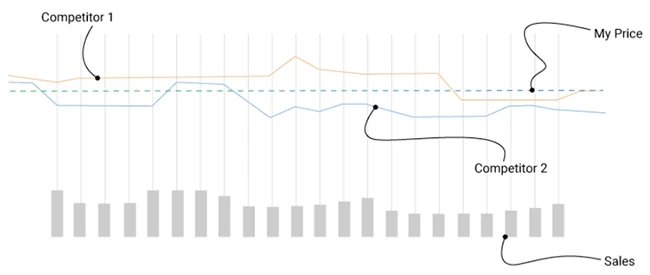Because launching an online business has little to no initial cost, aspiring entrepreneurs will likely face a number of rivals who may try to undercut their pricing. Therefore, it is important to monitor your competitors to determine what products they are offering at what price. Monitoring competitors’ product listings will give you a wealth of valuable information about your competitors—perhaps a well-funded rival is doing penetration testing into one of your niches, or maybe you’re trying a new competitor pricing model. No matter your business, knowing what your competitors are up to is one of the first steps to success.
Identify optimal pricing strategies using competitor listings
Price is one of the most important factors in a purchase decision. All customers take price into consideration when purchasing a product, and customers are more likely to research the product as the price tag increases. This is why it is important to know how competitors price a similar product to yours in a different channel, and then maintain a competitive price. This doesn’t always mean lowering the prices of your products—in fact, you may find that you’ve been charging less for a product than you should. To begin creating a pricing strategy using competitor listing data, start by answering the following questions:
What is my pricing model?
Begin by identifying the overall pricing model that works best for your product. If you’re selling toner cartridge replacements to small businesses, you’re probably working on an economy model, trying to undercut competitors’ prices. If you’re selling luxury handbags to celebrities, lowering your prices might hurt sales. Whether you’re working on a cost-plus or a value-based pricing model, it’s critical to know how many competing products or services you’re selling for.
How do my customers perceive the value of products?
Perhaps you have previously reduced the price of a product, but ultimately did not see an increase in sales. This is likely because your customers viewed your product differently than what the lower price conveyed. Cheaper prices don’t always determine buying decisions—instead, consumers are more willing to pay a price that they consider “reasonable” for the product they are buying. For this reason, retailers need to set prices based on the perception of the product to offer the best perceived product value. Checking prices against your competitors is one way to help you understand how consumers perceive similar products.
Comparing product assortment against competitors’ listings
With competitor monitoring, your main focus is benchmarking against your competitors to discover assortment gaps. Monitoring what products your competitors have recently added to their stores may give you valuable insight into market trends. If you have an online store that sells sports gear and you notice your competitors adding more dumbbells to various brands, you can surmise that they see dumbbells increasing in market value. This suggests that you should extend your assortment if you don’t have dumbbells in your store.
Who are my true competitors?
It is crucial to understand your competitor’s product assortment and be prepared to adjust with the market. However, it’s also important to be able to recognize who your true competitors are. More often than not, when we think of competitors, we think of businesses within the same industry—while this seems fine in theory, it’s not always true in practice. Benchmark against the wrong rivals, and your pricing and assortment strategy will fall short.
To find the right target, you need to calculate the price index. A concept borrowed from the economic sector, the price index is used to measure the rate of inflation. In the ecommerce realm, we can use it to examine how much impact competitors will have on your business.
To measure the price index for a certain product (for example, the dumbbells mentioned above), you must divide the cost of the competitor’s dumbbell by the cost of your store’s dumbbell and multiply by 100.
Read about: Why Do You Need An E-commerce Scraper For Competition Monitoring
Web Scraping in the Big Data Solution
Price Index = (Competitor’s Product Cost / Your Product Cost) x 100
One product’s price index won’t tell us anything valuable—we need to add the price index of each product and divide by the number of products to get the average product price index. Repeating the above calculations will provide us with each product price index per competitor. From there, we can connect all the data points through a visual graph and work on the deviations to determine which competitor has the most impact on us.

How do I conduct competitor monitoring?
Many data solution providers charge a lot of money just for competitor monitoring. However, despite the high cost, you still have to deal with the underlying problem of security. Web scraping tools like Octoparse serve as an alternative for prudent investors who are conservative on security while careful on spending. Octoparse provides businesses of any size with the ability to stay informed automatically, allowing retailers to keep an eye on all categories of each competitor across different web sources at a much lower cost.
The saying “Keep your friends close and your enemies closer” is especially true in the world of eCommerce. Businesses should routinely watch their counterparts, assess their strengths and weaknesses, and develop a marketing strategy accordingly to maximize their potential.




